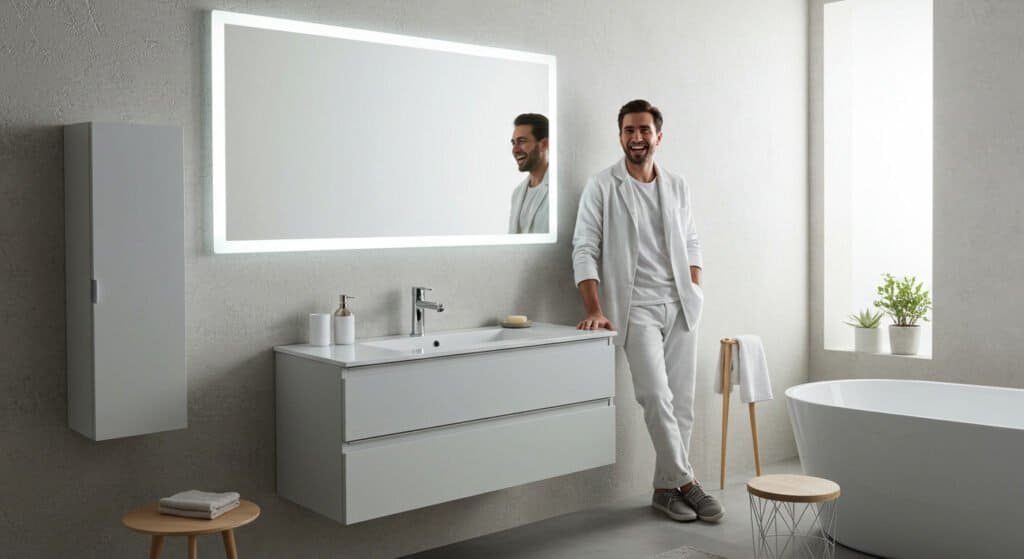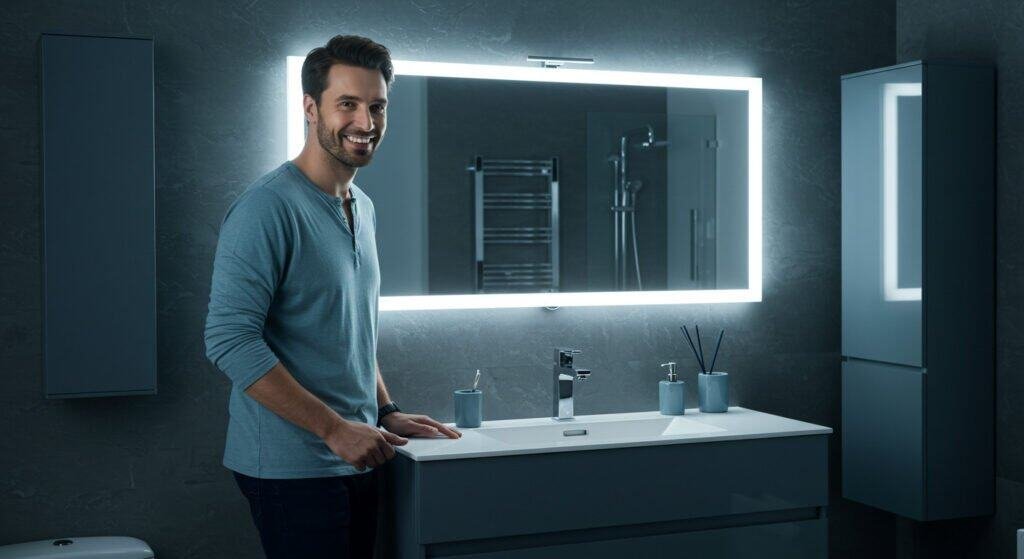How to choose a wall mirror size? Selecting the wrong mirror size creates visual imbalance, wastes valuable wall space, and diminishes your room’s aesthetic appeal. The right mirror transforms any space into a brighter, more spacious environment while serving its intended functional purpose.
To choose the right wall mirror size, measure your wall space and select a mirror that covers 60-75% of the available area. Consider the room’s function, existing furniture proportions, and ceiling height to ensure perfect visual balance and optimal functionality.
Understanding these fundamental principles helps you make informed decisions for every room in your home.
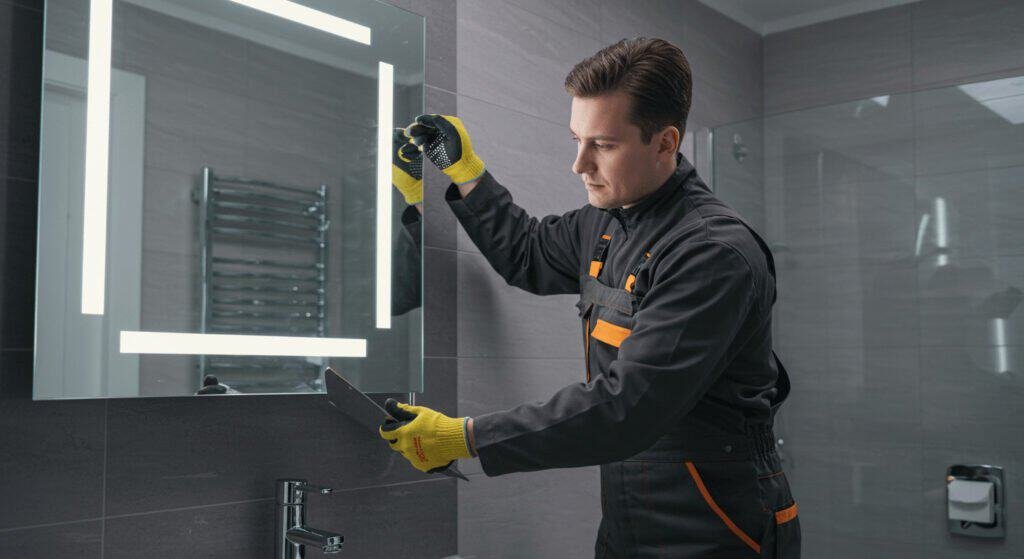
What Size Should a Wall Mirror Be?
If you’re hanging a mirror in a living room, hallway, or bedroom to create a focal point or to add light, a good rule of thumb is to hang the mirror so the center sit line is at eye level. This means that a six-foot-tall person’s eye line would be 3 feet from the floor.
A bathroom mirror should typically measure 2-4 inches narrower than your vanity on each side, while bedroom mirrors can range from 24-36 inches wide for decorative purposes. Full length mirror size in cm typically ranges from 120-180 cm in height and 30-60 cm in width.
The mirror size chart below gives general guidelines for use. Keep in mind when selecting modern lighted bathroom mirrors that you will need to account for space required for electrical wiring and placement of any switches. LED bathroom mirrors have become a trend with their energy efficiency and added features like a defogger and adjustable color temperature.
| Room Type | Recommended Width | Recommended Height | Purpose |
|---|---|---|---|
| Bathroom Vanity | 60-80% of vanity width | 24-36 inches | Daily grooming |
| Bedroom | 24-48 inches | 30-60 inches | Decoration/dressing |
| Living Room | 30-60 inches | 36-72 inches | Decoration/light reflection |
| Hallway | 18-30 inches | 24-48 inches | Space enhancement |
| Full-length | 16-24 inches | 48-68 inches | Complete body view |
How Do I Select a Mirror for My Space?
Selecting the right mirror involves a careful analysis of several variables including the dimensions of the room, the size of the furniture, and how you’ll be using it. The mirror size calculator approach is to measure your available wall space and calculate the mirror size with the 60-75% coverage rule.
Begin by measuring your wall width and height, then multiply by 0.6 to 0.75 to determine optimal mirror dimensions. Consider existing furniture relationships, particularly for bathroom vanity mirrors where proper proportions ensure both aesthetic appeal and functional effectiveness.
When it comes to lighted makeup mirrors, you need to consider where you’ll have access to your electrical and where the switches will be. Most lighted vanity mirrors use LED lights, which draw significantly less electricity and last much longer than regular bulbs.
Modern bathroom mirror designs often incorporate advanced features such as Bluetooth connectivity, temperature displays, and human body sensing technology. The vanity mirror size guide should account for daily usage patterns and the number of users who will regularly access the mirror.
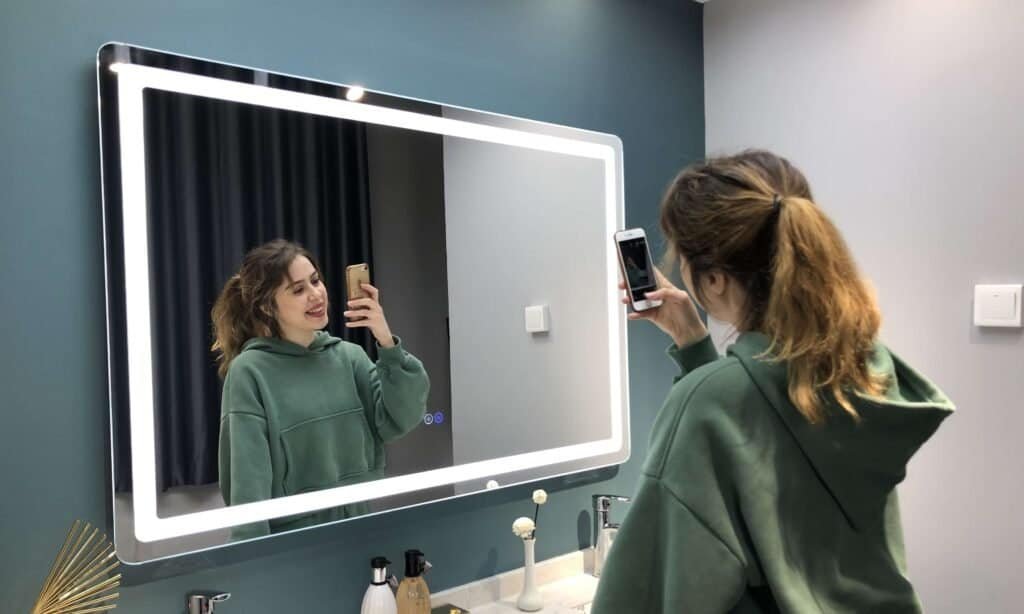
How to Choose a Wall Mirror Size in Inches?
Precise measurements in inches matter to ensure professional results and the best look. Use the bathroom mirror size calculator to figure exactly how big your mirror needs to be.
Start by measuring your wall width in inches, then multiply by 0.65 for standard sizing or 0.75 for more dramatic impact. Height calculations should consider ceiling proportions and nearby furniture relationships.
Standard mirror size for bedroom applications typically ranges from 24-36 inches wide and 30-48 inches tall. Lighted makeup mirror installations require smaller dimensions, usually 12-24 inches wide, to maintain appropriate viewing distances. Bathroom wall mirrors with lights need room for the electrical components and the heat to escape. Also, keep in mind the specific measurements that may be required for specialty mirrors, including mirrors with black frame options or modern LED vanity mirror designs.
| Vanity Width (inches) | Recommended Mirror Width (inches) | Recommended Mirror Height (inches) |
|---|---|---|
| 24 | 18-20 | 24-30 |
| 30 | 24-26 | 28-34 |
| 36 | 30-32 | 30-36 |
| 48 | 40-44 | 32-38 |
| 60 | 50-56 | 34-40 |
| 72 | 60-68 | 36-42 |
Can a Mirror Be Too Big for a Room?
Big mirrors can make a small room look bigger but not if it’s an oversized mirror. When mirrors take up too much space or contrast with the rest of a wall’s decor, they create imbalances within a room. If you have a small space, consider using one large mirror to create balance.
A mirror becomes too large when it exceeds 80% of the available wall space or dwarfs nearby furniture pieces. Small bathroom mirror installations should never extend beyond the vanity edges, as this creates an awkward visual disconnect.
Large mirrors can work in a small space if you know how to make them work. For a taller mirror, a good rule to follow is for the top of the mirror to not be higher than the tallest point in the room. This can mean that the top of the mirror is to the top of the door frame. In the design world, there are no strict rules, but you must be conscious of what the mirror is reflecting.

How to Choose a Wall Mirror Size for a Room?
To select the right mirror for a room, you need to think about what you’re going to do in that room. Pick the right mirror size for the job.
Living room mirrors should complement furniture arrangements and enhance natural light distribution throughout the space. Bedroom installations focus on dressing functionality while contributing to overall room aesthetics.
Room mirror ideas should incorporate the space’s primary activities and traffic patterns. Hallway mirrors benefit from vertical orientations that create height illusions, while dining room installations should avoid overwhelming seating arrangements. Lighted vanity mirrors for bathroom installations require careful coordination with existing lighting schemes. Consider the room’s color palette and material selections when choosing between LED mirror options and traditional glass mirror alternatives.
How to Choose a Wall Mirror Size for a Bathroom?
The relationship between mirror and vanity size affects both the functionality and balance of the mirror in the space. The size of your mirror influenced the balance and lighting in your bathroom.
Bathroom vanity mirrors should measure 2-4 inches narrower than the vanity top on each side, creating balanced proportions while preventing water damage to surrounding walls.
Modern bathroom mirror installations often incorporate LED technology for enhanced illumination and energy efficiency. Lighted bathroom mirror options provide superior visibility for grooming activities while reducing shadows common with overhead lighting alone. Bathroom light mirror installations should coordinate with existing vanity lights to avoid conflicting light temperatures.
When choosing an LED mirror, consider features like defogging, magnification areas, and touch controls. LED vanity mirrors allow you to change the brightness to your needs whether it’s morning or night or you’re putting on makeup or shaving.
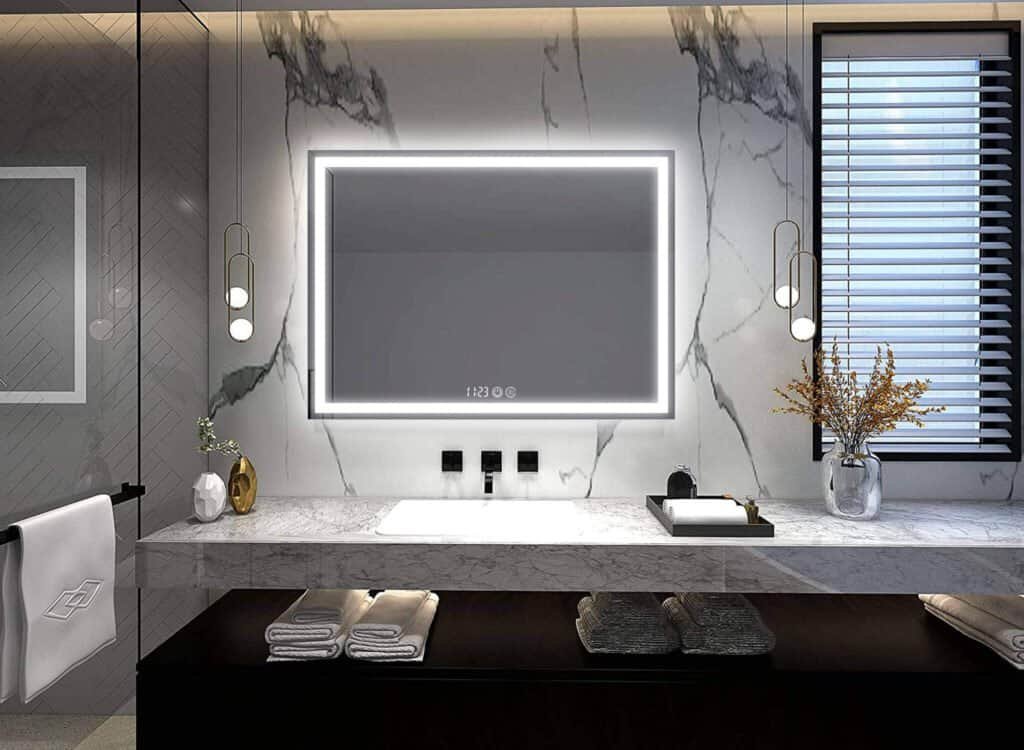
What Size Mirror Should Go Over a 60 Inch Vanity?
A 60-inch vanity requires a mirror measuring 50-56 inches in width to maintain proper proportional relationships and visual balance. This sizing ensures adequate coverage while preventing the mirror from extending beyond the vanity edges.
The optimal height for a 60-inch vanity mirror ranges from 34-40 inches, depending on ceiling height and user requirements. Consider the vanity’s backsplash height when determining final mirror placement.
Lighted vanity mirrors for bathroom installations over 60-inch vanities often incorporate multiple light zones for enhanced functionality. LED vanity mirror options provide consistent illumination across the entire mirror surface, essential for larger installations.
You’ll also want to make sure that the LED lights around the mirror match or complement the LED lights in your bathroom. If you have a larger bathroom vanity area, you can get the mirrors with the LED lights with dimmers and color change features.
Is a 40 Inch Mirror Too Small for a 48 Vanity?
A 40-inch mirror paired with a 48-inch vanity creates appropriate proportional relationships and falls within the recommended 75-85% coverage guideline. This combination provides adequate functional space while maintaining visual balance.
The 40-inch mirror width allows for 4-inch margins on each side of the 48-inch vanity, creating a classic proportional relationship that works well in most bathroom designs.
This sizing combination works particularly well for rectangular bathroom mirrors and suits most user requirements. Vanity mirror with LED lights installations in this size range provide excellent illumination coverage for daily grooming activities.
Make sure the mirrors are an appropriate height so that everybody in your home can see themselves. They also make backlit mirrors that are 40 inches wide if you want to get a little bit more sophisticated with the lighting in your room.
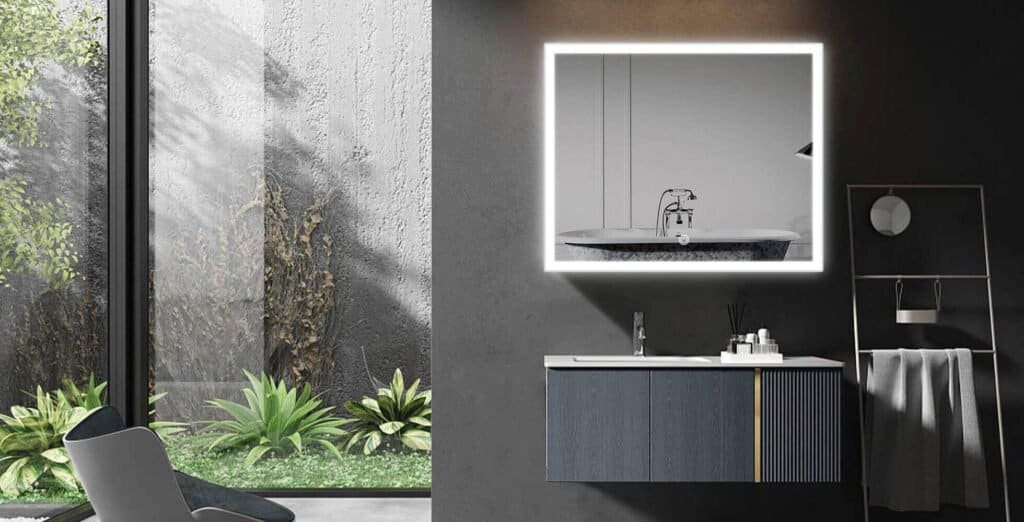
LED Mirror Size Considerations for Professional Projects
LED mirror installations for commercial and high-end residential projects require specialized sizing considerations beyond traditional mirror applications. These advanced mirrors incorporate electrical components, control systems, and enhanced functionality features.
Professional LED mirror sizing must account for electrical rough-in requirements, ventilation needs, and accessibility standards. Custom sizing capabilities allow for precise dimensional matching to architectural specifications.
Modern LED mirror technology enables customization to any size, shape, and function specification, making them ideal for unique architectural applications. Features such as three-color light switching, adjustable color temperature, defogging capabilities, Bluetooth music players, and human body sensing require additional space planning considerations.
Professional installations benefit from experienced suppliers who understand both technical requirements and aesthetic objectives. Consider long-term maintenance accessibility and electrical code compliance when specifying LED mirror dimensions for commercial applications.
Conclusion
Choosing the right wall mirror size requires careful consideration of room proportions, functional requirements, and design objectives. Professional guidance ensures optimal results that enhance both aesthetics and functionality for years to come.
- Clik here to know What Is Copper Free Mirror?
- If you donot know how too choose the right bathroom height click here.
- Know more about LED bathroom mirror Problems
- Clik here to know why Touch Sensor Mirror Not Working
- Clik here to know What Are Standard Vanity Mirror Sizes?
- Clik here to know Why Are Mirrors So Expensive?
- Clik here to know Do LED Mirrors Need Electricity?
- Clik here to know Is a Lighted Mirror Enough Light for a Bathroom?
- Find out 10 Common LED Bathroom Mirror Problems Click Here

